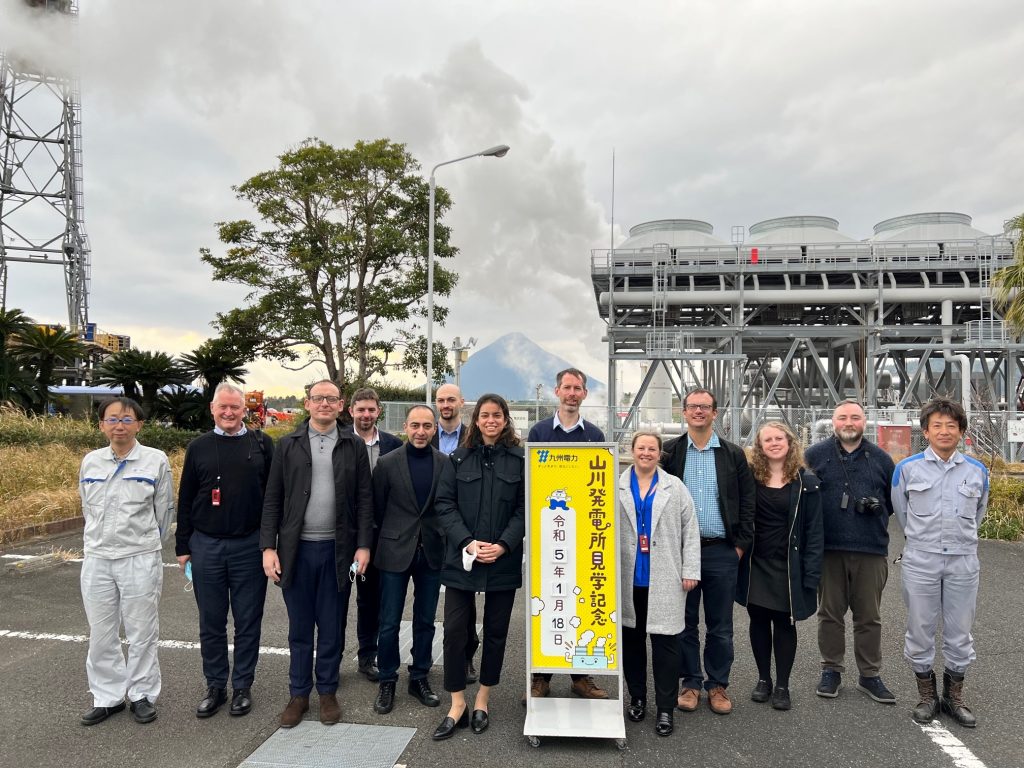
Daniella Dávila Aquije, left of the sign in the centre
By Daniella Dávila Aquije, Senior Manager (Building Safety), Greater London Authority
For details of the JST 2024 theme, schedule and how to apply see here.
The climate emergency is undoubtedly the defining challenge of our generation. While the focus is usually on national-level targets and commitments, actions taken locally can have the largest impact on reducing carbon emissions. Through the Japan Study Tour, I along with colleagues working in the local government sector in England, visited Japan earlier this year to learn about local government action taken to meet net-zero objectives. In Japan, an enviable level of financial autonomy has afforded local governments the power to implement innovative and impactful strategies to meet their sustainability objectives.
The move towards the generation and use of renewable energy seems to be at the core of all local net-zero strategies. During the programme, we visited solar, biomass, geothermal and hydroelectric power plants. However, what I found most memorable was a power station owned by the city council in Kagoshima Prefecture. This power station generates electricity by burning household waste. The heat derived from the incineration process is then fed into a turbine that generates electricity. The electricity is used by the facility and any surplus is sold to utility companies. This process also generates methane gas, which is recovered and sold to city gas facilities for household use. This incineration processing plant is both supporting the move towards renewable energy and facilitating sustainable waste management.
In addition to the decarbonisation of electricity, the push for the use of timber in both residential and non-residential construction was a common element of local net-zero strategies. Approximately 70 per cent of Japan’s land is forested, and large amounts of timber are generated through forest thinning (a process whereby trees are removed to avoid overcrowding). Governments actively encourage building owners to use domestically produced timber in construction. For example, in Minato City, there is a certification programme for new builds requiring businesses to use a minimum level of timber in the construction of commercial properties.
The push for timber was surprising to me. In England, there is a live debate on the use of cross-laminated timber (i.e. multiple layers of wood engineered into a single block) in construction (we only restrict its use in the external walls of buildings over 18 metres). Notwithstanding the sustainable properties of timber (embodied carbon is estimated to be 60 per cent lower than traditional construction), wood is a combustible material. While Japanese colleagues argued that timber could be treated to be non-combustible, there is not enough research or testing in the English context looking at the performance of wood in a fire.
Additionally, Japan seems to have a stronger regulatory system where building safety standards are kept up to date, not least motivated by the risk of seismic activity. In fact, the lifespan of buildings in Japan is between 30-40 years. While demolition by no means supports net-zero objectives, this approach seems to have allowed the construction sector to keep up with building safety measures. Anecdotally, sprinklers were fitted in every accommodation I stayed at in Japan. In England, retrofitting water suppression systems is too costly, and we can only expect these to be implemented in new builds. The fire at Grenfell Tower in 2017, which claimed the lives of 72 people, revealed the existence of a poor regulatory system, negligent testing and reporting of results, and a lack of accountability within the construction sector. It is no surprise that combustible materials, such as timber, will continue to be scrutinised until robust testing has been conducted and we have more certainty of their performance during a fire.
The climate emergency will continue pushing governments to adopt new and innovative strategies across the board, from power generation to construction. While a lot of work remains to be done, it was encouraging to see empowered and autonomous local governments in Japan pushing the net-zero agenda forward.
The lessons learned and reflections shared during the Japan Study Tour have been invaluable for me to better understand the myriad of solutions we can pursue to meet net-zero objectives. This experience has also reinforced the need for local government autonomy to tackle the climate emergency at the most proximate level. The tour was not only a wonderful opportunity to explore Japan, but it also offered a forum for critical discussions on arguably one of the most complex challenges of our generation.
Daniella Dávila Aquije
Senior Manager (Building Safety)
GREATER LONDON AUTHORITY

